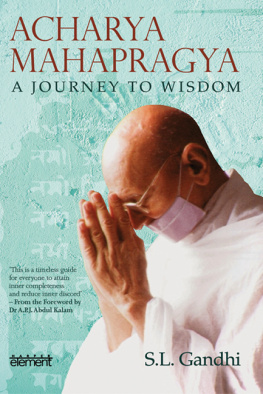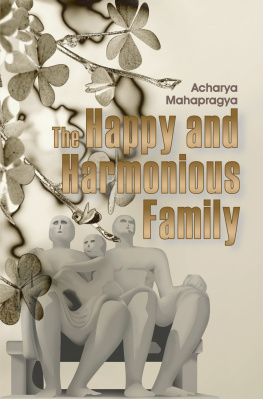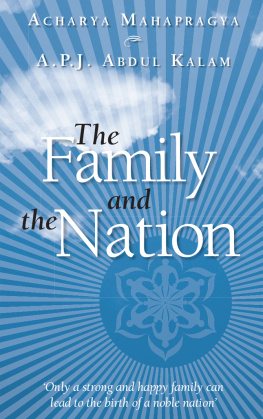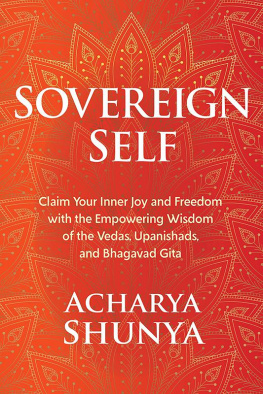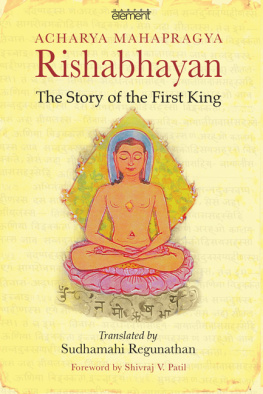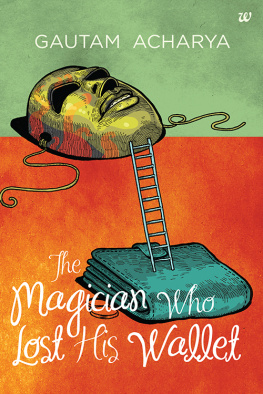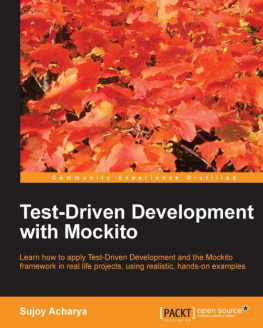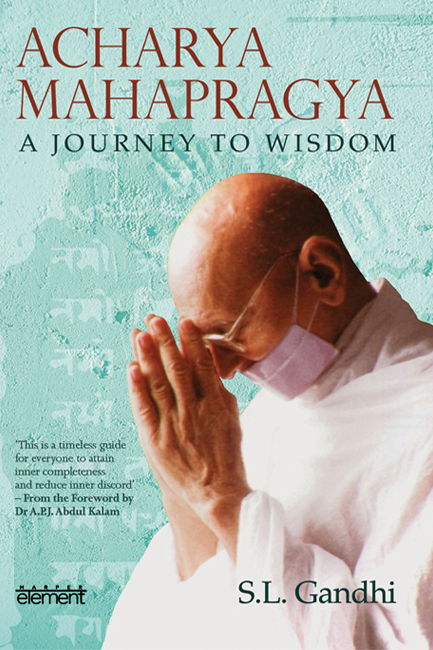
As a respectful acknowledgement of a humble
anuvrat workers debt to his great mentor,
philosopher and guide, this work is dedicated to
SHRI MOTILAL H. RANKA
Contents
It is very important to record the great deeds of noble souls. While this record must be objective, accurate and authentic in its content, it must also capture the true spirit and motivation of the propagator. This three-part book by Dr S.L. Gandhi on Acharya Mahapragya excels on both counts.
When I reflect on my association with Acharya Mahapragya, three phases come to my mind. I met him in connection with the Foundation for Unity of Religions and Enlightenment of Citizenship (FUREC). We together wrote the book The Family and the Nation . I myself got influenced by his life dedicated to the principles and practice in accordance with the doctrine of Terapanth and its stress on thirteen (tera in Hindi) religious principles, namely, five great vows, five regulations, and three restraints.
I had many personal sittings with Acharyaji. We come from two different religions but we were unanimous in our belief that society cannot be purged without an inner transformation of man. Acharyaji confided in me, The ideational phase of my movement is over. It is time I gave it a programmatic and practical shape. Let us transform the movement into a fitting instrument of constructive activities. That is how FUREC was born in Surat on 15 October 2003 in his presence.
Acharyaji told me, Kalam you are Anuvrati. You follow all five small vows for leading an upright life, namely, Satya (abstention from lying), Ahimsa (non-injury to anyone), Aparigraha (non-possessiveness), Achaurya (not taking what is not earned or rightfully given) and Brahmacharya (Chastity).
Acharyaji taught me Preksha Dhyana, the ancient Jain technique of meditation. It was of great help in combining knowledge from our scriptures, modern science and my experience. I realized, No country can emerge powerful without peaceful coexistence and it is impossible for a country to ensure peaceful coexistence of its people without restraint and discipline.
I am sure this book will serve the purpose of preserving the details of Acharya Mahapragyas distinguished life and his thoughts. This compendium is, indeed, a timeless guide for everyone to attain inner completeness and to reduce inner discord. It is indeed a modern agama.
Dr A.P.J. Abdul Kalam
Former President of India
arham
Man is contemplative and thoughtful by nature. He can formulate a beautiful plan on the basis of his power of thinking. Backed by his plan he can also implement it well. The more a persons thinking is free from raaga (love or attachment) and dvesha (hatred) and is endowed with prudence or wisdom, the more it can become focused and illuminating. The next higher stage of thinking is unthinking or thoughtlessness. He who transcends the state of thinking and attains the state of unthinking or thoughtlessness can realize the ultimate truth or supreme reality.
Acharya Mahapragya was a very wise and enlightened sage of the 20th/21st century. He renounced the household life at the age of 11 years and embraced asceticism. He lived the life of an ascetic for 79 years. He carried out the impossible task of editing the Jain agamas. He presented a system of meditation in the form of Preksha Dhyana which helps individuals to develop their spiritual practice. In order to uplift the values that build character in the world of education he put forth Jivan Vigyan (Science of Living). He became the tenth Acharya of the Jain sect called Terapanth. I hope the book by Dr Sohan Lal Gandhi about such a multi-dimensional personality as Acharya Mahapragya will prove to be a beacon for the people.
Acharya Mahashraman
Eleventh Acharya of Jain Swetambar Terapanth
Innumerable human beings who come into this world leave its precincts unwept and unsung. They do nothing to distinguish themselves from others and remain engrossed in the struggle to make ends meet. They appear unnoticed and vanish from the planet without making any contribution. No one ever thinks of them or remembers them. Only a few of them make their mark and leave behind a legacy of uniqueness.
The story of Acharya Mahapragyas life is a glorious story of ascetic refulgence. The journey of his life begins from a small village called Tamkor in the Jhunjhunu district of Rajasthan. At that time, this village didnt have even the most basic amenities like electricity, roads, a school, a dispensary nor were there any means of communication or transport. During the rainy season, the village remained virtually cut off from the rest of the state. In such an ambience of underdevelopment and ignorance, Acharya Mahapragya was born on 14 June 1920.
Though he was given the name of Indrachand during the naming ceremony, he was renamed as Nathmal since his nose was pierced and a ring inserted into it as part of the ritual to ensure his longevity. We wonder if the secret of Acharya Mahapragyas long life lay in this occult practice or it was sheer coincidence. I am convinced beyond doubt that the secret of his longevity lay in the calmness of his mind which he had attained by prolonged meditative practices and austerities.
When the child Natthu was hardly two and half months old, his father died. What astonishes me is that a child born and brought up in such adverse circumstances, without any formal schooling, develops his pragya (intelligence or sagacity) to so great an extent that he is widely recognized as mahapragya (a man of great wisdom). His ascent to the pinnacle of ascetic radiance was gradual and phenomenal. He grew up under the shadow of his devout mother. In those days things were extremely cheap. The child Natthus family had all the basic resources to live comfortably, but the loss of his father at this tender age was in itself a great disaster. His mother evinced extraordinary qualities of patience and perseverance and brought her children up in such a way that they hardly felt the vacuum.
She was a pious woman who woke up early in the morning and began her routine with a samayika (a Jain spiritual practice which enjoins a practitioner to abstain from all sinful activities for a period of 48 minutes). During this period she recited aloud a hymn in praise of the 24 Tirthankaras composed by the most revered Jayacharya, the fourth Acharya of Terapanth Religious Order. She also sang songs eulogizing Acharya Bhikshus virtues and the true path shown by him. The child Natthu, who remained in his bed, listened to these devotional songs and imbibed the spirit enshrined in them.
As we look back we come to know that he was temperamental by nature. He used to fly into a rage when his wish was ignored or his demand remained unfulfilled. In an enraged state of mind, he would refuse to eat his meals, stop studying and speaking and catch hold of a pillar or a door and would stay clinging to it. He refused to listen to anyone. The members of his family tried all strategies to placate him but they were in vain. When we analyse this aspect of his childhood days today, what puzzles us most is how a child who was so stubbornly persistent in his ways could grow into a perpetually peaceful and serene sage. With the awakening of his discretion and development of knowledge, his anger was almost conquered.
I have also discovered a common trait in spiritual leaders and scientists of eminence. Many were not at all bright in their studies at school or college and were considered mediocre by their teachers. Both Albert Einstein and Thomas Alva Edison, who turned out to be the greatest scientists of their time, didnt evince any mark of brilliance at school or college. Nevertheless they gave the world amazing and miraculous gifts. Einsteins theory of relativity revolutionized our understanding of matter, space and time. What is enigmatic is that this genius of the 20th century didnt show any sign of genius when he was a student. Edison, who was described by his teacher as rotten, addled and spoilt and who could not study in a school or college and was taught only by his mother, later invented the electric bulb, the phonogram, the telephone transmitter, the megaphone, the carbon transmitter and an early cine camera. He had more than 1,000 patents to his credit and was instrumental in changing the world.
Next page
